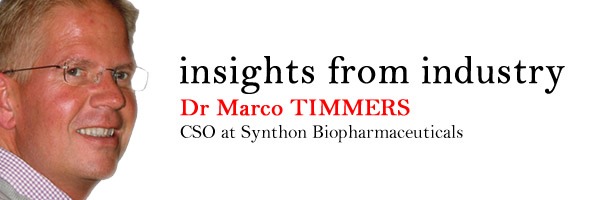
What are antibody-drug conjugates (ADCs) and what are they used for?
ADCs are used for a new type of targeted therapy that consists of a specific anti-cancer antibody or antibody fragment linked to a potent anti-cancer therapeutic.
Our ADCs deliver deactivated cytotoxins specifically to a cancer cell. Once in the tumor cell, the cytotoxins are released from the ADC, regaining their full cytotoxic activity, leading to rapid cell death.
What are the aims of using ADCs?
The aim for this class of therapy is to combine better tumour killing properties with lower side effects for cancer patients.
How effective at killing tumours are current types of cancer therapy and in what way will ADCs be better at killing tumours?
In the antibody-drug conjugation (ADC) approach, highly toxic molecules are attached to tumour-targeted antibodies thereby increasing their selective tumour cell-killing capability.
The antibody delivers the cell-killing agent directly to the tumour site and healthy tissue is protected against the devastating effects of the agent, since the ADC only binds to tumour cells.
Typically, an ADC binds to the tumour-associated target, is internalized and subsequently releases the potent drug inside the tumour cell.
How much of a problem are side effects with current cancer therapies? How will ADCs avoid side effects?
Because of the highly specific targeting of antibodies equipped with our ADC technology – only targeting tumour cells and sparing healthy cells - the side effects associated with this second generation type of cancer treatment are reduced compared to the conventional cytotoxin treatment protocols, which are non-selective and therefore also kill many healthy cells, which is the major cause of side effects in oncology treatments.
Please can you outline Synthon Biopharmaceuticals’ lead program of ADCs.
Synthon’s lead ADC program uses the HER2-binding antibody trastuzumab. We want to develop a broad therapeutic spectrum by targeting tumors that over-express HER2, a protein expressed on the outside of specific tumour cells and that has been shown to play an important role in certain aggressive types of cancer, such as metastatic breast cancer and non-small-cell lung cancer.
How is this program going?
The program is delivering on its promise and giving us very exciting pre-clinical results with the opportunity to become a Best-in-Class therapy.
In pre-clinical studies using patient-derived breast cancer and non-small-cell lung cancer material, we observe complete tumour remission, whereas dosing the antibody alone shows no effect.
How safe are ADCs?
For our second generation ADC, toxicity experiments conducted to-date show an impressive safety profile: clinically effective doses are not likely to show serious side-effects.
The difference between effective and toxic doses, the so-called therapeutic index, has been improved with at least one order of magnitude compared to competing ADC technologies.
How do Synthon Biopharmaceuticals’ ADCs compare to competitor ADC technologies?
In the past 10 years, we have invested heavily in optimizing our linker-drug technology, based on known issues with first generation ADCs, such as T-DM1 and Adcetris, particularly concerning toxicity.
Our ADC incorporates a duocarmycin prodrug, which is only activated inside the tumour cell. Duocarmycins are a class of very potent cytotoxins originating from Streptomyces bacteria.
A key feature of our technology is that it disrupts the DNA of (solid) tumor cells at any phase of the cellular cycle, unlike many other ADCs which only attack tumour cells in a dividing state. Another feature is that these cytotoxins can also be effective against tumour cells that are multi-drug resistant.
As mentioned before, our ADC has also shown a greatly improved therapeutic index compared to other armed antibodies, due to the impressive safety profile.
How long do you think it will be before Synthon Biopharmaceuticals’ ADCs are available for patients?
Our promising pre-clinical and toxicological findings should of course be substantiated in clinical trials. We expect that we can enter the clinic for a phase I clinical trial in 2014.
Typically, from that point it requires around five to six years before a product becomes available for patients since safety and (superior) efficacy need be demonstrated in larger patient populations.
What do you think the future holds for ADCs?
We strongly believe that advancing this second generation ADC technology will lead to a new class of effective, targeted medicines in oncology, an area still with high unmet medical need.
What are Synthon Biopharmaceuticals’ plans for the future?
Synthon’s ambition is to become a leading specialty pharmaceutical company, in our key focus areas of oncology and auto-immune/neurodegenerative diseases.
Our biopharmaceuticals portfolio is well populated to encompass multiple clinical-stage programs by 2016, as we expect many of our drug candidates to enter the clinic in the 2014-2016 timeframe.
We are committed to deliver innovative medicines to treat medically complex and serious conditions such as cancer and multiple sclerosis.
What is Synthon Biopharmaceuticals' goal?
Synthon is a company with a long history in affordable generic medicines, which are marketed and sold worldwide by our partner companies. Through our innovative project portfolio we are committed to making effective and safe medicines available at a reasonable price to patients around the world.
Where can readers find more information?
www.synthon.com
About Dr Marco Timmers
 Dr. Marco Timmers received his PhD in bio-organic chemistry from Leiden University, The Netherlands.
Dr. Marco Timmers received his PhD in bio-organic chemistry from Leiden University, The Netherlands.
In 1997, he joined Organon, where he became involved in various R&D projects in immunology, endocrinology and cardiovasculars.
In 2001, he was appointed head of medicinal chemistry, responsible for endocrinology and endocrinological oncology and combined this role with several project management positions of increasing responsibility, initially as Lead Optimization and later as Proof-of-Concept team leader, demonstrating efficacy of NMEs in clinical trials up to phase II.
In 2009, he became site head pharmacology after the acquisition of Organon by Schering-Plough and later Merck.
Early 2012, he joined Synthon Biopharmaceuticals, where he is currently employed as chief scientific officer, (co-)responsible for the transition of specialty pharma company Synthon into an innovation-driven company, focusing on oncology, auto-immune and neurodegenerative diseases.